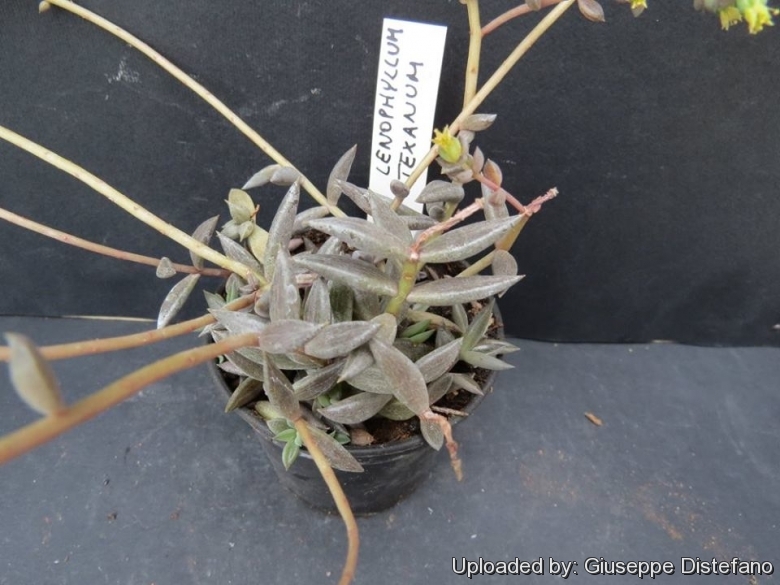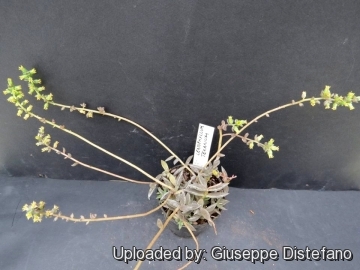
Lenophyllum texanum Photo by: Giuseppe Distefano
Origin and Habitat: Lenophyllum texanumSN|32146]]SN|32146]] is infrequent or rare, but locally abundant in southern Texas (Cameron and Starr counties) and Mexico (Nuevo León, Tamaulipas).
Altitude range: 0-50 metres above sea level.
Habitat and ecology: Lenophyllum texanumSN|32146]]SN|32146]] occurs near the coast on sand or sandy soil and on "clay dunes". This taxon is most prolific as the leaves readily fall off and root. It forms mats, often under cacti and other shrubs on the coastal plain and in the lower Rio Grande valley. In Cameron County this species grows in open prairies, or more often in shade in thornscrub and mixed alophyte communities on the clay lomas; in Starr County it grows in cracks in limestone at the tops of mesas. Rabbits and tortoises consume the plant. It is a host plant for the Xami Hairstreak butterfly (Callophrys xami).
Synonyms:
Common Names include:
ENGLISH: Charlie Brown's Texas Sedum, coastal stonecrop, Texas Stonecrop, Chisme, Texas sedum
Description: Lenophyllum texanum is a mostly creeping, hairless, succulent, perennial herb 10-40 cm tall, green becoming reddish. Plants are tufted, with shoots from axils of basalmost leaves, dying to base. The leaves are boat-shaped above, rounded beneath and fall easily all around at the slightest touch and will root, forming new plants.
The flowers are produced on slender upright, unbranched spikes above the foliage in winter, they are rosy-yellow, inconspicuous and not particularly attractive.
Stems: 1-4(-7) dm long, 1-3 mm wide, with 5-8 leaf pairs near base and to 15 pairs in all.
Leaves: Easily detached and rooting. Opposite. Blades thick and fleshy like those of Lenophyllum acutifolium, ovate-lanceolate to elliptic to oblanceolate, acuminate, about 10-25 mm long, 4-10 mm wide, 3-5 mm thick, apex acuminate with tip 1 mm long, green when young. turning lavender-green or reddish with age.
Inflorescences: Flowering-stems erect or spreading. 10-35 cm long, pinkish. Racemes (or spikes or narrow thyrses) 2-15 cm long, 12-20 mm wide at the stem ends not secund but equilateral, 5-20-branched with compact, 1(-3)-flowered cincinni; branches mostly 1-flowered.
Flowers: Radial. Sepals oblanceolate-ovate, acute to acuminate 2.5-4 mm long, 1-2.5 mm wide. Petals, distinct, oblanceolate, oblong,acute, buffy or dull yellow with dark purple blotch at tip, 5-6 mm long, 2 mm broad. Corolla 3.5 × 5-7 mm (open). Stamens yellow. All floral parts persistent.
Blooming season: Late summer - early winter.
Fruits: Brown, 7-8 mm long, separating into several erect, many-seeded follicles.
Seeds: ca. 0.6 mm.
Chromosome number: 2n = 88.
Bibliography: Major references and further lectures
1) Moran, Reid V. «Lenophyllum texanum (J. G. Smith) Rose, Smithsonian Misc. Collect. 47: 162. 1904.». Flora of North America. eFloras. Vol. 8 Page 225 <http://www.efloras.org/florataxon.aspx?flora_id=1&taxon_id=250092157> Web 19 December 2015.
2) Uhl, C. H. 1 “Chromosomes and polyploidy in Lenophyllum (Crassulaceae).” Amer. J. Bot. 83: 216-220. 1996.
3) Alfred Richardson “Plants of Deep South Texas: A Field Guide to the Woody and Flowering Species” Texas A&M University Press, 2011
4) Urs Eggli “Illustrated Handbook of Succulent Plants: Crassulaceae” Springer Science & Business Media, 06 December 2012
5) Jackie M. Poole “Rare Plants of Texas: A Field Guide” Texas A&M University Press, 2007
6) “Smithsonian Miscellaneous Collections” Smithsonian Institution, 1862
7) “Annals of the Missouri Botanical Garden” 6: t. 50, 1895
8) “Addisonia” 8: t. 267, 1923
9) Clausen. “Sedum of North America”, 586, 1975.
10) James Cullen “The European Garden Flora Flowering Plants: A Manual for the Identification of Plants Cultivated in Europe, Both Out-of-Doors and Under Glass” Cambridge University Press, 11 August 2011
 Lenophyllum texanum Photo by: Giuseppe Distefano
Lenophyllum texanum Photo by: Giuseppe DistefanoSend a photo of this plant.The gallery now contains thousands of pictures, however it is possible to do even more. We are, of course, seeking photos of species not yet shown in the gallery but not only that, we are also looking for better pictures than those already present.
Read More... Cultivation and Propagation: Lenophyllums are closely related to Echeveria and with similar cultivation requirements. All can be readily rooted from leaf cuttings or seed. It is essential in cultivation to use a very porous soil, with adequate drainage. Lenophyllum reflexumSN|32145]]SN|32145]] is a small, slowly spreading groundcover that grows only a few cm tall, it grows most prolifically under glass and is a pernicious weed in greenhouses, the leaves easily dropping off at the slightest touch and each at once starts a new colony. The stems die back after flowering and seem to go into a brief dormancy overwinter. New shoots and plantles reappear in the pot in mid- to late winter. Its succulent leaves are green in a shady site and brownish in sun.
Exposition: Bright light is required to prevent "stretching" of Echeverias ("stretching" occurs when a moderately fast growing plant such as an Echeveria or Lenophyllum, is grown in dim light or over-fertilized, which causes overly lush growth that contributes to weak, pallid plants).
Watering: Water thoroughly when soil is dry to the touch.
Hardiness: It is recommended for zones 7 to 10. Protect from frost.
Aerosol salt tolerance: It is reported to be salt tolerant.
Propagation: Quite easy from seed or from cuttings, the latter either from individual leaves or from offset rosettes.











